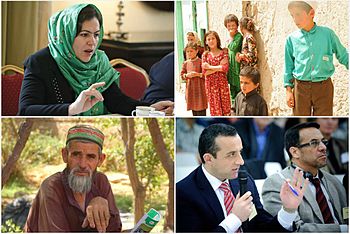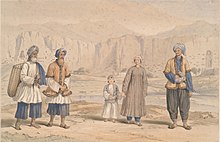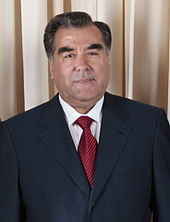Tajiks
![]()
Tajik is a redirect to this article. For other meanings, see Tajik (disambiguation).
The word Tajik (Persian تاجيک, DMG Tāǧīk; tdk. Тоҷик), in earlier forms also Tāzīk or Tāžīk with the original meaning "Arab", has been another name for "Persian" since the Middle Ages, especially in the Iranian- and Turkic-speaking parts of the Islamic world.
The name has its actual origin in the Arabic tribal name "Ṭayyiʿ". These had settled as the most prominent Arab group in Central Asia after the Muslim conquest of Persia. In the course of the Turkish and Mongol conquest of Central Asia, the name was first applied to all Muslims, but later specifically to the Persian-speaking and Iranian majority of the region's population.
Today, the term is understood to refer primarily to the Persian-speaking population of Central Asia, primarily Tajikistan, which is named after them. In a broader sense, the term is also extended at the political level to related neighbouring peoples in Afghanistan and China, but this is not always uniform. For example, the Hazara and Aimaks, who are also Persian-speaking, are not usually counted as "Tajiks", while non-Persian-speaking but Iranian peoples in China or Mountain Badakhshan are considered "Tajiks", e.g. the Tajiks of China.
As a self-designation, the literary Neo-Persian term Tajik, which originally had a pejorative use as a term for Persian or Iranian, has become increasingly acceptable, especially in the 20th century, due to modern boundaries and differentiation from Persians in modern Iran. Alternative names for the Tajiks include Persians from the East, Fārsīwān (Persian/Persian-speaking), and Dīhgān, which translates as "peasant or sedentary villager," by extension "settled" as a contrast to "nomadic."
In Sassanid and early Islamic times, the term Dīhgān was used for landowners and barons of "Noble Persian Blood".

Tajiks of Afghanistan
Historical construct
The history of the Tajiks is composed of the individual history of each of the Iranian peoples of the region. It begins with the immigration of the Aryans into Central Asia (ca. 2000 BC), continues with the emergence of Zoroastrianism (ca. 1700 BC), the rise of the Persian Empire (550 BC), the triumphal march of the Macedonians (330 BC. Chr.), the empire of the Parther (220 B.C.), the empire of the Sassanids (220 A.D.) and the conquest of Persia by the Arabs (650 A.D.), with which the actual history of the Tajiks begins.
The Tajiks trace their origins to the Iranian Samanid dynasty (900 AD), the first indigenous rulers after the Arab invasion and before the Turkish conquest. During Samanid rule, the Persian language and Iranian culture were revived. This "rebirth" of Iranian in Central Asia is generally considered to be the origin of today's Tajiks.
The modern currency of Tajikistan, somoni, goes back to the name of that dynasty.
For the more detailed history of the Tajiks, see also:
Ancient
- Aryans, the ancestors of today's Persians
- Avesta, the holy book of Parsism
- Persian Empire
- Parthian
- Bactrian
- Sogdier
- Sassanids, the last ancient empire of the Persians
- Tocharian
- Kushan
Medieval
- Barmakids
- Samanids, the first independent Persian dynasty after the Muslim conquest. It is considered the origin of the Tajik identity
- Ghurids, a sultanate from Ghor which ruled over large parts of Central Asia and India
Modern Times
- Afghanistan
- Tajikistan
- Iran

Tajiks in Bamiyan, Afghanistan (Charles Haghe, 1843)

Emomalij Rahmon, President of Tajikistan, cultivates a distinct personality cult around himself and styles the Tajiks of his country as the successors of the Samanids.
See also
- Galtscha (Mountain Tajik)
Questions and Answers
Q: What are Tajiks?
A: Tajiks are a Persian-speaking Iranian ethnic group who are mostly found in what is now Tajikistan, including in parts of Afghanistan, Uzbekistan and China. Alternative names for the Tajiks are (Eastern) Persian, Dehqan, and Farsiwan.
Q: When did some Tajik refugees escape to live in neighboring countries?
A: After the Soviet invasion of Afghanistan in 1979, some Tajik refugees escaped to live in neighboring Iran and Pakistan.
Q: What religion do most Tajiks follow?
A: Most Tajiks are Sunni Muslims, but a few in remote mountain areas follow Shia Islam alongside pockets in cities such as Herat and Kabul.
Q: How did the name "Tajik" begin being used for this group of people?
A: The name Tajik being used for this group of people began in the early 20th century by the Russians. Before that, they were called Sarts.
Q: What language do Tajiks speak?
A: The Tajiks speak a form of Persian language called Tajiki in Tajikistan and Uzbekistan, and officially called Dari in Afghanistan.
Q: Where did historians believe that the Tajiks may be connected to ancient Aryans from?
A: Historians believe that the Tajiks may be connected to ancient Aryans who lived in Central Asia for thousands of years. They were included in empires like Persia and Alexander the Great's empire over time as well as mixed with later invaders like Mauryans, Kushans and Hepthalites.
Q: How did Mongols settle into many popular Persian cities after wiping out its population?
A: In the 13th century Genghis Khan and his Mongol army settled into many popular Persian cities after wiping out its population. These Mongols later adopted the Persian language and religion of Islam with some claiming partial descent from them
Search within the encyclopedia